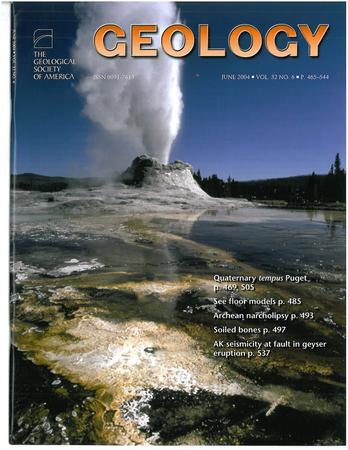Surface uplift of the central Cascade Range, northwestern USA, via Oligocene to early Miocene crustal thickening
IF 4.6
1区 地球科学
Q1 GEOLOGY
引用次数: 0
Abstract
Paleoelevation data from continental arcs provide a record of tectonic processes and reveal feedbacks between surface uplift and paleoclimate. Here we reconstruct the Oligocene–Miocene paleoelevation of the central Cascade arc (northwestern USA) using δD values of paleoprecipitation preserved within hydrated volcanic glass. From the early Oligocene to early Miocene (ca. 33–17 Ma), we observe a 30‰ decrease in δD values of samples collected east of the range. Interpreted using a Rayleigh distillation model, these data indicate arc elevations increased by 1.1 ± 0.4 km during this interval, coeval with geochemical evidence for a 12 km increase in Moho depth. In the context of existing geochemical, thermochronologic, and structural data, Oligocene to early Miocene surface uplift was predominantly driven by magmatic additions to the crust during a period of high magmatic production rates. Surface uplift was synchronous with leeward drying, suggesting that an orographic rain shadow was established by the early Miocene. These results highlight the role of crustal thickness and paleoelevation changes in controlling regional climate in magmatic arcs.美国西北部喀斯喀特山脉中部经渐新世至早中新世地壳增厚的地表隆起
大陆弧的古高程数据提供了构造过程的记录,揭示了地表隆起与古气候之间的反馈关系。本文利用水化火山玻璃中保存的古沉淀δD值重建了美国西北部喀斯喀特弧中部渐新世-中新世古海拔。早渐新世至早中新世(约33 ~ 17 Ma),其东侧样品δD值下降了30‰。使用瑞利蒸馏模型解释,这些数据表明,在这段时间内,弧高程增加了1.1±0.4 km,与地球化学证据一致,莫霍深度增加了12 km。在现有地球化学、热年代学和构造资料的背景下,渐新世至早中新世的地表抬升主要是由岩浆高产时期的地壳岩浆补充作用驱动的。地表隆起与背风干燥同步,表明中新世早期形成了地形雨影。这些结果突出了地壳厚度和古高程变化对岩浆弧区域气候的控制作用。
本文章由计算机程序翻译,如有差异,请以英文原文为准。
求助全文
约1分钟内获得全文
求助全文
来源期刊

Geology
地学-地质学
CiteScore
10.00
自引率
3.40%
发文量
228
审稿时长
6.2 months
期刊介绍:
Published since 1973, Geology features rapid publication of about 23 refereed short (four-page) papers each month. Articles cover all earth-science disciplines and include new investigations and provocative topics. Professional geologists and university-level students in the earth sciences use this widely read journal to keep up with scientific research trends. The online forum section facilitates author-reader dialog. Includes color and occasional large-format illustrations on oversized loose inserts.
 求助内容:
求助内容: 应助结果提醒方式:
应助结果提醒方式:


